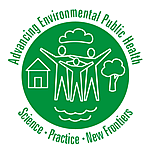-
The National Center for Environmental Health and the Agency for Toxic Substances
and Disease Registry (NCEH/ATSDR), CDC, hosted its seventh National
Environmental Public Health Conference. The theme of the conference was “Advancing
Environmental Public Health:
- Environmental public health program managers and practitioners who represent federal, state, tribal, and local governments, including those responsible for preparedness and response to terrorism and natural disasters
- Academicians and students from schools of public health, and from universities and colleges with environmental public health programs
- Representatives of advocacy and community-based organizations
- Representatives of Industry
- Physicians
- Public health nurses and students from schools of nursing
- Toxicologists
- Laboratorians
- Researchers
- Health education specialist and communication specialists
- Epidemiologists
- Statisticians
- Urban planners
- Policy and decision makers
 Science, Practice, New Frontiers.”
Science, Practice, New Frontiers.”
Date: December 4 - 6, 2006
Location: Hilton Atlanta Hotel
255 Courtland Street, NE
Atlanta, Georgia 30303
(404) 659-2000
Attendance: 1,600+
The conference addressed the need to revitalize environmental public health, and how to chart the nation's vision for the future. There were six plenary sessions, 75 workshops, and 40 exhibits and poster displays that addressed a wide-range of topics from emerging threats to a myriad of everyday environmental public health issues.
Topics included bio-monitoring; climate change; environmental justice; environmental public health tracking; food and water protection; health disparities; healthy places and healthy homes; indoor air quality; injury prevention; laboratory science and service; preparedness & response; public health policy and law; toxicants, exposures, and contaminants; vector management; and workforce development.
The conference brought together a cross-section of federal, state, tribal, local, and international colleagues within the field of environmental public health and its allied professions, including:
|
|
|
Continuing Education Units (CEU) were available for attendances at the conference.


